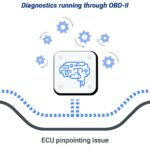Connecting multiple devices to your car’s OBD2 port can seem tricky since there’s only one. This guide clarifies how to use two OBD2 devices effectively and safely.
Understanding OBD2 Port Limitations
Almost every car manufactured after 1996 has an OBD2 port, designed initially for mechanics to diagnose vehicle issues. Its functionality has expanded to include heads-up displays, GPS trackers, diagnostic tools, and even projecting maps onto your car’s windshield. However, a crucial limitation remains: the OBD2 port can only accommodate one device at a time. It lacks the capability to split or use a hub like a USB port.
Connecting Multiple OBD2 Devices: One at a Time
The straightforward solution is to use one device at a time. If you need to switch between a heads-up display and a GPS tracker, you must disconnect one before connecting the other. While there are cables marketed as OBD2 splitters, they are often unreliable and not recommended. Sticking to a single device ensures consistent performance and avoids potential issues.
Safety Considerations for Connecting and Disconnecting OBD2 Devices
The OBD2 connector is built to be durable, designed to last the lifetime of your vehicle. Occasional device changes shouldn’t cause harm. However, frequent connecting and disconnecting (e.g., 20 times a day) is not advised. The most significant risk isn’t to the car but to the user – be mindful of your surroundings to avoid bumping your head! The OBD2 connector carries low voltage and poses no electrical hazard.
Can an OBD2 Device Damage Your Car?
Damage from an OBD2 device is highly unlikely. While the OBD2 standard allows for data transmission to the car, typically used by mechanics with specialized software for advanced diagnostics or programming, consumer-grade devices available on the market pose minimal risk.
Choosing the Right OBD2 Device for Your Needs
Prioritize your needs when selecting an OBD2 device. If real-time driving data is crucial, a heads-up display might be your best choice. For tracking your vehicle’s location, a GPS tracker is more suitable. Determine which function is most important and choose the corresponding device.
Conclusion: Managing Multiple OBD2 Devices
Using two or more OBD2 devices requires connecting them one at a time due to the port’s inherent limitations. Prioritize your needs, choose the right device for each task, and practice safe connection/disconnection habits. This ensures optimal performance and avoids potential damage. Remember to always consult your car’s manual for any specific instructions regarding OBD2 device usage.
